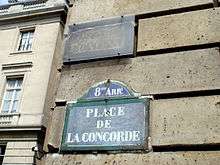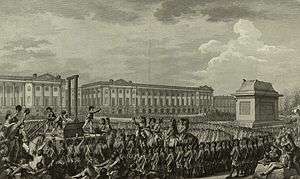Place de la Concorde
Coordinates: 48°51′56″N 2°19′16″E / 48.86556°N 2.32111°E
|
The Place de la Concorde as seen from the Eiffel Tower | |
 | |
| Length | 359 m (1,178 ft) |
|---|---|
| Width | 212 m (696 ft) |
| Arrondissement | 8th |
| Quarter | La Madeleine |
| Construction | |
| Completion | 1772 |
| Denomination | 1830 |
The Place de la Concorde (French pronunciation: [plas də la kɔ̃kɔʁd]) is one of the major public squares in Paris, France. Measuring 8.64 hectares (21.3 acres) in area, it is the largest square in the French capital. It is located in the city's eighth arrondissement, at the eastern end of the Champs-Élysées.
History
The place was designed by Ange-Jacques Gabriel in 1755 as a moat-skirted octagon between the Champs-Elysées to the west and the Tuileries Garden to the east. Decorated with statues and fountains, the area was named the Place Louis XV to honor the king at that time. The square showcased an equestrian statue of the king, which had been commissioned in 1748 by the city of Paris, sculpted mostly by Edmé Bouchardon, and completed by Jean-Baptiste Pigalle after the death of Bouchardon.
At the north end, two magnificent identical stone buildings were constructed. Separated by the rue Royale, these structures remain among the best examples of Louis Quinze style architecture. Initially, the eastern building served as the French Naval Ministry. Shortly after its construction, the western building became the opulent home of the Duc d'Aumont. It was later purchased by the Comte de Crillon, whose family resided there until 1907. The famous luxury Hôtel de Crillon, which currently occupies the building, took its name from its previous owners.
French Revolution
During the French Revolution in 1789 the statue of Louis XV of France was torn down and the area renamed the Place de la Révolution. The new revolutionary government erected a guillotine in the square, and it was here that King Louis XVI was executed on 21 January 1793.
Other important figures guillotined on the site, often in front of cheering crowds, were Queen Marie Antoinette, Princess Élisabeth of France, Charlotte Corday, Madame du Barry, Georges Danton, Camille Desmoulins, Antoine Lavoisier, Maximilien Robespierre, Louis de Saint-Just and Olympe de Gouges.


In 1795, under the Directory, the square was renamed Place de la Concorde as a gesture of reconciliation after the turmoil of the French Revolution. After the Bourbon Restoration of 1814, the name was changed back to Place Louis XV, and in 1826 the square was renamed Place Louis XVI. After the July Revolution of 1830 the name was returned to Place de la Concorde and has remained that way since.
Features

- To the west of the Place is the famous Champs-Élysées.
- To the east of the Place are the Tuileries Gardens. The Galerie nationale du Jeu de Paume and the Musée de l'Orangerie, both in the Tuileries Gardens, border the Place
- North of the Place: two identical stone buildings, separated by the Rue Royale. The eastern one houses the French Naval Ministry, and the western one is the Hôtel de Crillon. The Rue Royale leads to the Église de la Madeleine. The Embassy of the United States is located in the corner of the Place at the intersection of Avenue Gabriel and Rue Boissy d'Anglas
- The northeastern corner of the Place is the western end of the Rue de Rivoli
- South of the Place: the River Seine, crossed by the Pont de la Concorde, built by Jean-Rodolphe Perronnet between 1787–1790 and widened in 1930-1932. The Palais Bourbon, home of the French National Assembly, is across the bridge, on the opposite bank of the river
- At each of the eight angles of the octagonal Place is a statue, initiated by architect Jacques-Ignace Hittorff, representing a French city:
- Brest and Rouen by Jean-Pierre Cortot
- Lyon and Marseille by Pierre Petitot
- Bordeaux and Nantes by Louis-Denis Caillouette
- Lille and Strasbourg by James Pradier. After the Franco-Prussian War of 1870-1871, when Alsace-Lorraine was lost to Germany, the Strasbourg statue was covered in black mourning crepe on state occasions,[1] and was often decorated with wreaths; this practice did not end until France regained the region following World War I.[2]
Obelisk
.jpg)
The center of the Place is occupied by a giant Egyptian obelisk decorated with hieroglyphics exalting the reign of the pharaoh Ramesses II. It is one of two the Egyptian government gave to the French in the 19th century. The other one stayed in Egypt, too difficult and heavy to move to France with the technology at that time. In the 1990s, President François Mitterrand gave the second obelisk back to the Egyptians.
The obelisk once marked the entrance to the Luxor Temple. The self-declared Khedive of Egypt, Muhammad Ali Pasha, offered the 3,300-year-old Luxor Obelisk to France in 1829. It arrived in Paris on 21 December 1833. Three years later, on 25 October 1836, King Louis Philippe had it placed in the center of Place de la Concorde.
The obelisk, a yellow granite column, rises 23 metres (75 ft) high, including the base, and weighs over 250 metric tons (280 short tons). Given the technical limitations of the day, transporting it was no easy feat — on the pedestal are drawn diagrams explaining the machinery that was used for the transportation. The obelisk is flanked on both sides by fountains constructed at the time of its erection on the Place.
Missing its original cap, believed stolen in the 6th century BC, the government of France added a gold-leafed pyramid cap to the top of the obelisk in 1998.
The fountains

The two fountains in the Place de la Concorde have been the most famous of the fountains built during the time of Louis-Philippe, and came to symbolize the fountains in Paris. They were designed by Jacques Ignace Hittorff, a student of the Neoclassical designer Charles Percier at the École des Beaux-Arts. The German-born Hittorff had served as the official Architect of Festivals and Ceremonies for the deposed King, and had spent two years studying the architecture and fountains of Italy.
Hittorff's two fountains were on the theme of rivers and seas, in part because of their proximity to the Ministry of Navy, and to the Seine. Their arrangement, on a north-south axis aligned with the Obelisk of Luxor and the Rue Royale, and the form of the fountains themselves, were influenced by the fountains of Rome, particularly Piazza Navona and the Piazza San Pietro, both of which had obelisks aligned with fountains.
Both fountains had the same form: a stone basin; six figures of tritons or naiads holding fish spouting water; six seated allegorical figures, their feet on the prows of ships, supporting the pedestal, of the circular vasque; four statues of different forms of genius in arts or crafts supporting the upper inverted upper vasque; whose water shot up and then cascaded down to the lower vasque and then the basin.
The north fountain was devoted to the Rivers, with allegorical figures representing the Rhone and the Rhine, the arts of the harvesting of flowers and fruits, harvesting and grape growing; and the geniuses of river navigation, industry, and agriculture.
The south fountain, closer to the Seine, represented the seas, with figures representing the Atlantic and the Mediterranean; harvesting coral; harvesting fish; collecting shellfish; collecting pearls; and the geniuses of astronomy, navigation and commerce.[3]
References in popular culture
In the 1961 experimental documentary Chronique d'un été, Marceline Loridan-Ivens walks through the Place de la Concorde while reflecting on memories of her father and her time in Auschwitz-Birkenau.
In the Star Trek novels, the Place de la Concorde is the location of the offices of the President and the Council of the United Federation of Planets.
In The Devil Wears Prada, Andrea Sachs throws her phone into one of the Fontaines de la Concorde.
Angel, the seventh book in the Maximum Ride novel series, includes the Place de la Concorde as a rally area to a crime organization known as the Doomsday Group.
In the video game Tom Clancy's EndWar, the Place de la Concorde is across the bridge from the spawn point and is a major firefight zone. The zone is also showcased in the trailer, Russians use the square for cover and the Luxor Obelisk is heavily damaged. Later in the trailer a transport aircraft crashes in the center of the square. In the end a missile lands in the background and destroys the square.
In Matthew Reilly's first novel in the Jack West Jr series, Seven Ancient Wonders, the Place de la Concorde is the resting place of a piece of the capstone to the Great Pyramid at Giza.
In the novel Tender is the Night by F. Scott Fitzgerald, Rosemary and Dick pass through the Place de la Concorde several times during their secret liaison.
In the music video of "Tendrement" by Koffi Olomide on his album Affaire D'etat he is seen walking round Fontaines de la Concorde.
The Luxor Obelisk is mentioned in the song "Il est cinq heures, Paris s'éveille" by Jacques Dutronc.
See also
- Execution of Louis XVI
- List of works by James Pradier
- The 1920s redesign of Logan Circle (Philadelphia) was based on the Place de la Concorde and includes near-copies of the Hôtel de Crillon and Hôtel de la Marine and an allegorical fountain representing the rivers of the Philadelphia area.
References
- ↑ "Carrie LeFlore Perry". Retrieved 2007-03-10.
- ↑ "The last week, the road to war". Retrieved 2007-03-10.
- ↑ Beatrice Lamoitier, L'essor des fontaines monumentales, in Paris et ses fontaines, pg. 173.
External links
| Wikimedia Commons has media related to Place de la Concorde (Paris). |
- Images of the Place: Series of images of the Place de la Concorde from the 18th to the 20th century
- Place de la Concorde Audioguide
- Place de la Concorde
- Satellite image from Google Maps
- Color picture from 1917
- Photos and Info
- The obelisk from the Luxor Temple

